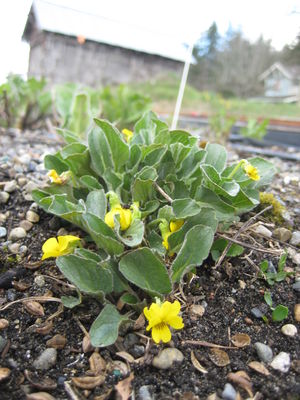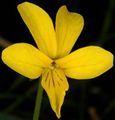Difference between revisions of "Viola nuttallii var. praemorsa"
(→Description) (Tag: VisualEditor) |
|||
| Line 28: | Line 28: | ||
===Description=== | ===Description=== | ||
| − | + | BurkeGeneral: Perennial from short, erect rhizomes, the stems up to 15 cm. long. | |
Leaves: Leaf blades conspicuously hairy, thick and fleshy, entire, ovate-lanceolate, 5-10 cm. long; petiole 5-15 cm. long; stipules attached to the petiole, the free portion few-toothed. | Leaves: Leaf blades conspicuously hairy, thick and fleshy, entire, ovate-lanceolate, 5-10 cm. long; petiole 5-15 cm. long; stipules attached to the petiole, the free portion few-toothed. | ||
| Line 35: | Line 35: | ||
Fruit: Fruit a hairy, 3-valved capsule, ovary superior, placentation parietal.<ref name=":0">WTU Herbarium, Burke Museum, & University of Washington. | Fruit: Fruit a hairy, 3-valved capsule, ovary superior, placentation parietal.<ref name=":0">WTU Herbarium, Burke Museum, & University of Washington. | ||
Retrieved from https://biology.burke.washington.edu/herbarium/imagecollection/taxon.php?Taxon=Viola%20nuttallii%20var.%20praemorsa</ref> | Retrieved from https://biology.burke.washington.edu/herbarium/imagecollection/taxon.php?Taxon=Viola%20nuttallii%20var.%20praemorsa</ref> | ||
| + | |||
| + | BCGeneral: Perennial herb from a fibrous root, without stolons; stems erect, sparsely to densely hairy, largely underground but the aerial stems 6-30 cm tall. | ||
| + | |||
| + | Leaves: Basal leaves egg-shaped to lanceolate, entire or slightly wavy, sparsely to densely hairy, the blades 2-10 cm long, 1-3.5 cm wide, the stalks 3-15 cm long; stem leaves lacking or few, similar; stipules joined to the stem with the free end entire to toothed, sparsely to densely hairy. | ||
| + | |||
| + | Flowers: Inflorescence of single, axillary flowers; petals 5, yellow, the lower petal 12-20 mm long including the 1- to 2-mm long spur, the lower 3 usually brown-penicilled and sometimes tinged with brown, the lateral pair bearded; sepals 5, lanceolate; style heads bearded. | ||
| + | |||
| + | Fruits: Capsules, smooth to hairy, 6-11 mm long; seeds dark brown. | ||
| + | |||
| + | '''Habit:''' Perennial herb 7.5--30 cm, glabrous to densely puberulent. '''Stem:''' prostrate to erect, generally several, clustered on 1--several subterranean caudices from woody rhizome. '''Leaf:''' simple; basal 1--5 per caudex, petiole 4.3--19.2 cm, blade 2.3--8.5 cm, 1.4--3.7 cm wide, elliptic or ovate, entire, wavy, or generally irregularly crenate to serrate, base tapered, often oblique to +- truncate, tip acute or obtuse; cauline blade 2.6--5.8 cm, 1.3--3.5 cm wide, like basal. '''Inflorescence:''' axillary; peduncle 2.7--26 cm. '''Flower:''' sepals lanceolate, ciliate or not; petals deep lemon-yellow, upper 2, sometimes lateral 2 maroon or +- brown abaxially, lower 3 veined brown-purple, lateral 2 bearded with cylindric hairs, lowest 12--20 mm. '''Fruit:''' 6--12 mm, elliptic to oblong, glabrous to minutely puberulent. '''Seed:''' 2--3 mm, medium to dark brown, +- 1/3 length covered by outgrowth. | ||
| + | |||
| + | Perennial, rhizomatous herb with axillary yellow flowers, to 30 cm tall.<ref name=":1">Jepson Herbarium Online Flora. Retrieved from https://ucjeps.berkeley.edu/eflora/eflora_display.php?tid=53398</ref> Stems several, erect, borne from underground caudices,<ref name=":1" /> hairy.<ref name=":2">E-Flora | ||
| + | BC: Electronic Atlas of the Flora of British Columbia. Retrieved from https://linnet.geog.ubc.ca/Atlas/Atlas.aspx?sciname=Viola%20praemorsa&redblue=Both&lifeform=7</ref> Leaves mostly basal,<ref name=":2" /> not coarsely veined, crenate to serrate,<ref name=":3" /> hairy, fleshy, petiolate, ovate-lanceolate, to 10 cm, petioles to 15 cm long.<ref name=":0" /> Flowers 5-merous, solitary, axillary, zygomorphic; sepals 5, lanceolate;<ref name=":1" /> petals 5, lowermost larger and spurred, upper 4 in 2 pairs;<ref name=":3" /> lower 3 petals with brown-purple veins, lateral 2 bearded;<ref name=":1" /> stamens 5, connivent around pistil;<ref name=":3" /> pistil 3-carpellate with 1 style,<ref name=":3" /> bearded stigma<ref name=":0" /> and superior ovary with parietal placentation becoming a ellipsoid to oblong<ref name=":3" /> 3-valved capsule.<ref name=":0" /> | ||
===Bloom Period=== | ===Bloom Period=== | ||
April-July | April-July | ||
===Distribution=== | ===Distribution=== | ||
| − | Both sides of the Cascades, into Northern California, east to Montana, Wyoming and Northern Utah.<ref>Hitchcock, C. L., Cronquist, A., Giblin, D., & Legler, | + | Both sides of the Cascades, into Northern California, east to Montana, Wyoming and Northern Utah.<ref name=":3">Hitchcock, C. L., Cronquist, A., Giblin, D., & Legler, |
B. et al. (2018). ''Flora of the Pacific Northwest: an illustrated manual''. | B. et al. (2018). ''Flora of the Pacific Northwest: an illustrated manual''. | ||
Seattle: University of Washington Press.</ref> | Seattle: University of Washington Press.</ref> | ||
Revision as of 16:32, 30 June 2021
- Scientific Name: Viola nuttallii var. praemosa
- Family: Violaceae
- Common Names: canary violet, upland yellow violet, yellow montane violet
- Synonyms/Misapplications: V. praemorsa, V, praemosa vars. flavovirens, linguifolia
- Codon: VIONUT
Contents
Taxonomy
| Scientific classification | |
|---|---|
| Kingdom: | Plantae |
| Subkingdom: | Viridiplantae |
| Phylum: | Tracheophyta |
| Subphylum: | Spermatophytina |
| Class: | Magnoliopsida |
| Subclass: | Rosanae |
| Order: | Malpighiales |
| Family: | Violaceae |
| Genus: | Viola L. |
| Species: | Viola nuttallii Pursh |
| Subspecies: | Viola nuttalli var. praemorsa (Douglas ex Lindl.) S. Watson (not accepted) |
| Synonyms | |
| |
Description
BurkeGeneral: Perennial from short, erect rhizomes, the stems up to 15 cm. long. Leaves: Leaf blades conspicuously hairy, thick and fleshy, entire, ovate-lanceolate, 5-10 cm. long; petiole 5-15 cm. long; stipules attached to the petiole, the free portion few-toothed.
Flowers: Flowers with peduncles shorter than the leaves; flowers 8-15 mm. long, yellow, the upper petals brownish-backed, the lower 3 penciled with brownish-purple, the lateral pair bearded; style head bearded, rounded.
Fruit: Fruit a hairy, 3-valved capsule, ovary superior, placentation parietal.[2]
BCGeneral: Perennial herb from a fibrous root, without stolons; stems erect, sparsely to densely hairy, largely underground but the aerial stems 6-30 cm tall.
Leaves: Basal leaves egg-shaped to lanceolate, entire or slightly wavy, sparsely to densely hairy, the blades 2-10 cm long, 1-3.5 cm wide, the stalks 3-15 cm long; stem leaves lacking or few, similar; stipules joined to the stem with the free end entire to toothed, sparsely to densely hairy.
Flowers: Inflorescence of single, axillary flowers; petals 5, yellow, the lower petal 12-20 mm long including the 1- to 2-mm long spur, the lower 3 usually brown-penicilled and sometimes tinged with brown, the lateral pair bearded; sepals 5, lanceolate; style heads bearded.
Fruits: Capsules, smooth to hairy, 6-11 mm long; seeds dark brown.
Habit: Perennial herb 7.5--30 cm, glabrous to densely puberulent. Stem: prostrate to erect, generally several, clustered on 1--several subterranean caudices from woody rhizome. Leaf: simple; basal 1--5 per caudex, petiole 4.3--19.2 cm, blade 2.3--8.5 cm, 1.4--3.7 cm wide, elliptic or ovate, entire, wavy, or generally irregularly crenate to serrate, base tapered, often oblique to +- truncate, tip acute or obtuse; cauline blade 2.6--5.8 cm, 1.3--3.5 cm wide, like basal. Inflorescence: axillary; peduncle 2.7--26 cm. Flower: sepals lanceolate, ciliate or not; petals deep lemon-yellow, upper 2, sometimes lateral 2 maroon or +- brown abaxially, lower 3 veined brown-purple, lateral 2 bearded with cylindric hairs, lowest 12--20 mm. Fruit: 6--12 mm, elliptic to oblong, glabrous to minutely puberulent. Seed: 2--3 mm, medium to dark brown, +- 1/3 length covered by outgrowth.
Perennial, rhizomatous herb with axillary yellow flowers, to 30 cm tall.[3] Stems several, erect, borne from underground caudices,[3] hairy.[4] Leaves mostly basal,[4] not coarsely veined, crenate to serrate,[5] hairy, fleshy, petiolate, ovate-lanceolate, to 10 cm, petioles to 15 cm long.[2] Flowers 5-merous, solitary, axillary, zygomorphic; sepals 5, lanceolate;[3] petals 5, lowermost larger and spurred, upper 4 in 2 pairs;[5] lower 3 petals with brown-purple veins, lateral 2 bearded;[3] stamens 5, connivent around pistil;[5] pistil 3-carpellate with 1 style,[5] bearded stigma[2] and superior ovary with parietal placentation becoming a ellipsoid to oblong[5] 3-valved capsule.[2]
Bloom Period
April-July
Distribution
Both sides of the Cascades, into Northern California, east to Montana, Wyoming and Northern Utah.[5]
Habitat
Grasslands, shrub-steppe, open forest. Moisture Regime-Moist Shade Tolerance-Intolerant
Photo Gallery[2]
References
- ↑ Integrated Taxonomic Information System. Retrieved from https://www.itis.gov/servlet/SingleRpt/SingleRpt?search_topic=TSN&search_value=847695#null
- ↑ 2.0 2.1 2.2 2.3 2.4 WTU Herbarium, Burke Museum, & University of Washington. Retrieved from https://biology.burke.washington.edu/herbarium/imagecollection/taxon.php?Taxon=Viola%20nuttallii%20var.%20praemorsa
- ↑ 3.0 3.1 3.2 3.3 Jepson Herbarium Online Flora. Retrieved from https://ucjeps.berkeley.edu/eflora/eflora_display.php?tid=53398
- ↑ 4.0 4.1 E-Flora BC: Electronic Atlas of the Flora of British Columbia. Retrieved from https://linnet.geog.ubc.ca/Atlas/Atlas.aspx?sciname=Viola%20praemorsa&redblue=Both&lifeform=7
- ↑ 5.0 5.1 5.2 5.3 5.4 5.5 Hitchcock, C. L., Cronquist, A., Giblin, D., & Legler, B. et al. (2018). Flora of the Pacific Northwest: an illustrated manual. Seattle: University of Washington Press.





